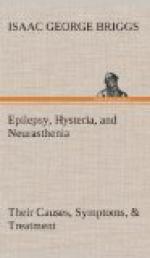The effect of epilepsy on the general health is not serious, but it has a more serious effect on the mind, for epileptic children cannot go to school (though special schools are now doing something towards removing this serious disability), and grow up with an imperfect mental training. They become moody, fretful, ill-tempered, unmanageable, and at puberty fall victims to self-abuse, which helps to lead to neurasthenia. Then they may drift slowly into a state of mental weakness, and often require as much care as imbeciles. If the fits are severe from an early age, arrest of mental development and imbecility follow. If the disease be very mild in character, and especially if it be petit mal, the victim may be very precocious, get “pushed” at school, and later become eccentric or insane.
Adult victims necessarily lead a semi-invalid life, often cut off from wholesome work and from the pleasures of life, and become hypersensitive, timid, impulsive, forgetful, irritable, incapable of concentration, suspicious, show evidences of a weakened mind, have few interests, and are difficult to manage.
About 10 per cent—the very severe cases—go on to insanity; either temporary attacks of mania, calling for restraint, or permanent epileptic dementia with progressive loss of mind. Some victims are accidentally killed in, or die as a result of a fit; about 25 per cent—severe cases again—die in status epilepticus, but the majority after being sufferers throughout life are finally carried off by some other disease.
There are many exceptions to this general course. Some patients have attacks very infrequently, and are possessed of brilliant talent, though apt to be eccentric. Others may have a number of seizures in youth, and then “outgrow” the complaint.
A few victims are attacked only after excessive alcoholic or sexual indulgence, some women only during their menses, while other women are free from attacks during pregnancy, which state, however (contrary to popular belief), commonly aggravates the trouble. Victims may be free from attacks during the duration of, and for some time after, an infectious disease; while Spratling says that a consumptive epileptic may have no fits for months, or even years.
Some epileptics are normal in appearance, but many show signs of degeneration. This is common in the insane, but less frequent and pronounced in neurasthenics. An abnormal shape of the head or curvature of the skull, a high, arched palate, peculiarly-shaped ears, unusually large hands and feet, irregular teeth from narrow jaws, a small mouth, unequal length and size of the limbs, a projecting occiput, and poor physical development may be noted.
These are most pronounced in intractable cases, in whom mental peculiarities are most frequently seen—either dullness, stupidity and ungovernable temper, or very marked talent in one direction with as marked an incapacity in others. In all epileptics, the pupils of the eye are larger than normal, and, after contracting to bright light soon enlarge again.




